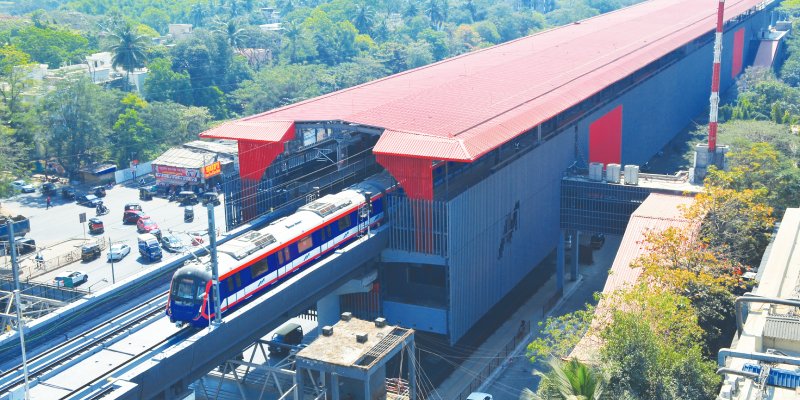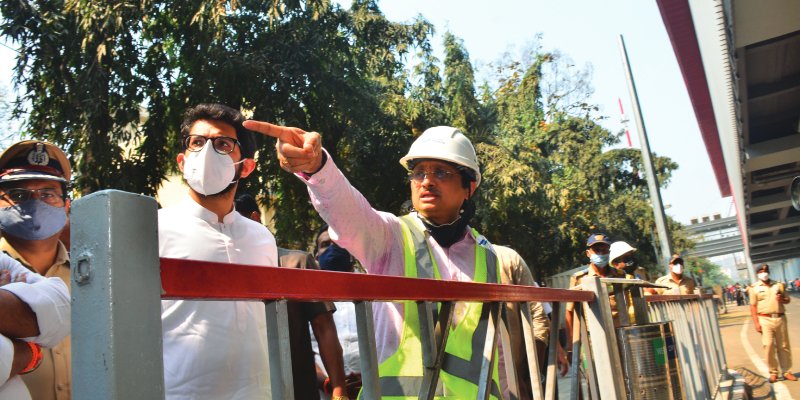 S.V.R. Srinivas, the Commissioner, Mumbai Metropolitan Region Development Authority, is sure in a hurry. Just about nine months in the office, he is pushing himself and his teams to complete the crucial projects that are long been awaited by the Mumbaikars.
S.V.R. Srinivas, the Commissioner, Mumbai Metropolitan Region Development Authority, is sure in a hurry. Just about nine months in the office, he is pushing himself and his teams to complete the crucial projects that are long been awaited by the Mumbaikars.

With a few days left for the opening of Metro line 2A and 7, Srinivas took time off to speak to Trafficinfratech’s Mangala Chandran. There are challenges, says he, nevertheless, is enjoying meeting them head-on.
Greetings from Trafficinfratech. You have always been involved in developing urban infrastructure. However, how did you plan so much in this short time and how did you come so close to the opening of Metro lines 2A and 7 probably by April. What have been your strategies and how did you manage this?
Thank you very much for this interview opportunity. As you know, it has always been a close collaboration of over a decade with TrafficInfraTech since my earlier days.
Any project of this scale and complexity is not easy. These two lines together constitute to about more than `12,000 crore; it is not a small amount and the projects are going on. When I joined, about nine months back, the issue was how to commission them. Commissioning & completing ongoing projects is a different ball game and it requires different skill sets, different strategies and different approaches. Even if you take a house, for example, building foundation and making walls are okay but if you want to get in, or want to do a so- called ‘house warming’ it is not that easy. Multiple aspects have to fall in place.
To begin with, the stations were not ready, the systems were not ready, there was only one train that had arrived. Even the dynamic trials had not started, and dynamic trials are the core of any metro train systems.
We made a catch-up plan for this, not only for the metro projects but also for several other projects as well depending on each project. Coming to this project we had made a plan whereby multiple, parallel working groups can do their tasks in a parallel way.
It was not easy because all of a sudden, we had Covid 3; so it was quite tough and June to September was the rainy season. Imagine we have a rainfall of about 2400mm while London has only 625 mm on an average. It was also difficult because during Covid, many teams had to work from abroad and getting visas was not easy. There was a standoff of government of India with the UK and we had to somehow manage the visas. Even after coming, the teams working with signaling, communication and trains were not used to working remote and it was not easy. We had to establish the links with continuous follow up of multi-disciplinary components because this project is highly inter-disciplinary and there are about 25 to 40 contractors at any given point of time along with thousands of skilled workers.
All had to be done and to summarize these, we made a catch-up plan. Now we are close to the opening after the completion of CMRS inspections and other tests including fire tests that are pending.

You have summarized the challenges very well. But to me, there have been many other challenges. Like managing the densely populated urban areas that come in the route plan, lack of enough work space, removing encroachments, barricading the construction sites, controlling the traffic, ensuring safety etc.
The challenges for the Mumbai projects are multifold and they are not easy to overcome. The first challenge for any city like Mumbai is underground utilities. I have worked in Mumbai Corporation for nearly four years and also in the Urban sector for almost twenty years. I was in MMRDA, I was in MSRDC and a couple of Municipal Corporations as Commissioner for almost seven years before coming to Mumbai.
In Mumbai in particular, there are more than forty utilities. If you just start trenching you will have water supply lines, sewerage lines, storm water lines, optical fibre cables, electrical cables. In Mumbai these are not even mapped because they are almost 150 years old.
You have to keep things/systems running, the traffic running and do the project at the same time. All these are elevated projects, both metro lines 7 and 2A are elevated projects. In fact, I would say underground metro is much easier because you put a TBM and it runs whereas in elevated projects, each girder has to be laid, it has to be lifted. Any small mistake can lead to severe loss of life and limbs. So that is a big challenge.
Secondly, the traffic cannot be just stopped because the project is going on for more than five years; you can’t stop any road for one year or so, that is not possible.
Most important as I see it is the social aspect. There are several stories which can be told and written by social or urban historians, urban planners later on. The issue is concerning the rehabilitation and resettlement of the project affected people. There are hundreds of people who are living on the roads, in the slums and the metro lines go through the occupied space. I had experienced it myself.
In metro line 2A for example there was a place called Adarsh Nagar on the Linking Road and on SV Road. There, the Metro l had come on both the sides of a slum and the work had to be stopped for about 150 meters. No work was going on for the last six years because of that. The land belonged to the Housing Board; the encroachment removal authority was BMC! First, we had to rehabilitate them somewhere and then we had to construct and that was completed, of course, in a record three months time.
I will give you another example, on line 7 also, there was a station on the western express highway called Kurar, now called Puspha Park. There were more than 75 shops, peoples’ livelihoods were involved. The metro station was ready but you could not approach the station because there was no staircase or escalator. The train would be going at the first level or second level and you have to reach them with staircases, escalators and elevators. That could not happen for last six years, again because of rehabilitation issues. There were shops, we had to rehabilitate all of them and we did that last August and completed the work. Rehabilitation and resettlement of affected persons, especially in urban areas and urban settings, is very complex and challenging because we don’t have many houses or vacant tenements.
Corona, the fourth challenge, is common to all the projects around the world so I would not like to dwell at length on that.
Most important or equally important and the fifth challenge is of course multidisciplinary, interdisciplinary team coordination and at the same time ensuring that the project goes through as planned. We were giving daily tasks to different teams and also ensured that they worked in tandem. Some teams are based in Mumbai but many teams are outside Mumbai, in Delhi, Bangalore, Chennai and many other places. Also there were teams working from abroad, so coordinating with them and within the time line was another challenge. These challenges are common to most of the projects but much more so in Mumbai than elsewhere.
There are several players, for example, the trains were manufactured by BEML and the software was coming from Alstom. Some software was coming from Hitachi and people could not come from abroad. The testing of the train, for example, the dynamic testing had started but a lot of tests had to be conducted abroad also and that was not easy. So far, let me tell you as an update, we got permission from the government of India for the rail rolling stock. The inspection is on and once the clearances are given then within one month we will be ready for commercial operations.
Can we throw light on some of the technological highlights, for example, CBTC?
The technologies involved are many but these keep changing. The same technology that has been here will be outdated very soon but I would still like to highlight a few- the driverless train technology and Communications-based Train Control. The train is supposed to run even if there is no driver and it is supposed to run from OCC- Operations Control Centre- that is located in Charkop in Mumbai. There are some technologies called ATP and ATO- Automatic Train Protection & Automatic Train Operations. There is TCMS software- Train Control Management System- which actually integrates all the different systems. For example, when the train comes, the PSDs- Platform Screen Doors- have to open in tandem with the train doors. It cannot happen that the PSD is closed and the train door is open or the reverse way and it has to exactly stop in front of the doors. That is one part, the second part is regarding signaling and communications.
So we can say, we have moved ahead, technology wise from Line 1
It is different, because CBTC was not there in Line 1, that technology was not so developed. In fact DMRC also got it a couple of years ago, so it is new to everybody. But at the same time, initially we will run the train in ATP (Automatic Train Protection) mode which is actually the most important aspect of any metro rail unlike suburban rail. This means our trains are failsafe, meaning thereby even if the system fails passengers are safe; for example, one train is running and some other train comes in front, then both the trains stop. There will never be a head-on collision because they are going to run on the ATP mode. Initially we would like to run on the ATP mode for six to seven months as in India, people are still not used to driverless train. We will then move to CBTC.
Another is the signaling technologies and they are extremely complex. In fact, the metro technologies are as complex as an aeroplane technology except that the train does not have the escape velocity to run and is not designed for that. We are using all the latest technologies and we are in for good times hopefully.
 TrafficInfraTech Magazine Linking People Places & Progress
TrafficInfraTech Magazine Linking People Places & Progress